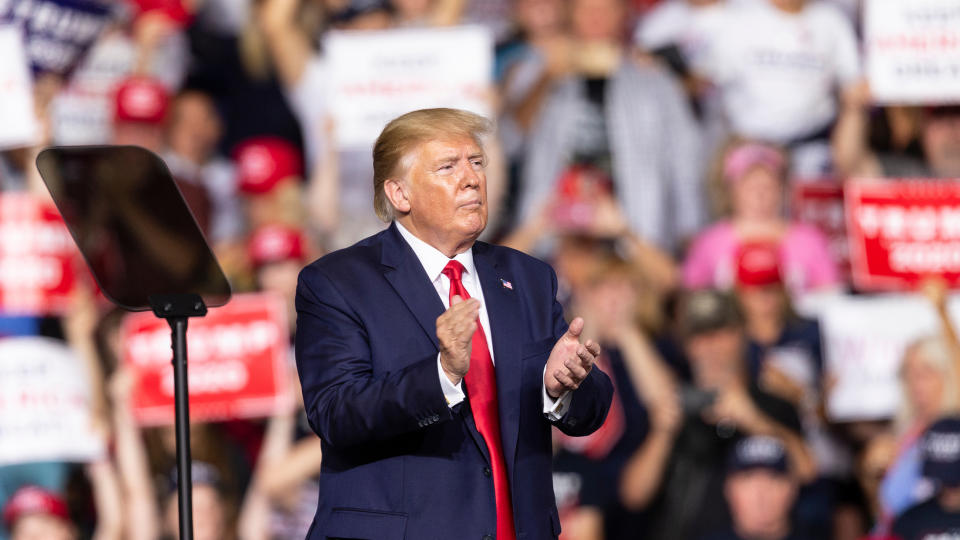3 Ways a Second Trump Presidency Would Benefit the Working Class Financially

According to the Center for American Progress, “The majority of America’s workers are part of the working class.”
Different organizations and advocacy groups use varied criteria to define “working class” — which is sometimes used synonymously with “blue collar” — but according to Forbes, working-class people tend to work for hourly wages instead of annual salaries and perform manual labor, often working with their hands or tools. Another significant and widely accepted differentiator is the lack of a four-year college degree among blue-collar workers.
Find Out: How Rich Is Former President Donald Trump?
Read Next: Owe Money to the IRS? Most People Don’t Realize They Should Do This One Thing
It was a reliably Democratic demographic from the time of Franklin D. Roosevelt and the New Deal. However, “a historic realignment of working-class voters helped Trump defy the odds and win in 2016, and brought him to within a hair of reelection in 2020,” according to Politico.
Here’s how a second Trump term could benefit one of his most critical voting blocs.
What Does the Working Class Want?
According to the Center for American Progress, “The major industrial policies that President Joe Biden has signed into law — the Inflation Reduction Act, the Infrastructure Investment and Jobs Act (IIJA), and the CHIPS and Science Act — will help provide millions of quality jobs to people without college degrees.”
Whether or not that will eventually prove true, it seems that most working-class Americans are eager to return to the previous administration’s policies.
According to the Brookings Institution, “When asked which president in recent decades had done the most for average working families, 44% named Donald Trump, compared to just 12% for Joe Biden.”
While some respondents to the Brookings poll mentioned cultural issues, a large majority of working-class Americans who pine for the Trump era are focused on financial concerns like inflation, employment, housing and the economy. Here’s how Trump could address those concerns in a second term.
Check Out: Net Worth for US Families: How To Tell if You’re Poor, Middle Class, Upper Middle Class or Rich
Aggressive Trade and Immigration Policies Could Boost Domestic Production and Wages
Tariffs and other aggressive trade policies were among the hallmarks of Trump’s term in office. While organizations like Brookings and the Carnegie Endowment for International Peace say those policies cost the U.S. jobs and that American consumers and businesses paid most of the tab, many experts aren’t surprised that the working class is cheering for more of the same because a trade war could increase domestic production and bring some manufacturing back home.
“The long-term trend in trade in manufactured goods is inshoring,” said James P. Pinkerton, former domestic policy advisor in the Ronald Reagan and George H.W. Bush White Houses, and author of the new book “The Secret of Directional Investing: Making Money Amidst the Red-Blue Rumble.”
“Countries are realizing that free trade has adverse effects on not only workers, but also on countries’ knowledge base. That is, if production is offshore, so is the know-how — and that spells slowed productivity increases,” he said.
This dynamic directly relates to one of Trump’s other major policy priorities, and it’s one that deeply concerns many working-class Americans: cheap labor competition flooding in from the southern border.
“These trends will be favorable for domestic workforces and should lead to higher wages, but that depends on the management of immigration,” Pinkerton said. “Loose labor markets mean lower wages. A tight labor market means higher wages.”
The Working Class Hopes Trump Will Bring More Jobs That They Can Fill
Since working-class Americans are responsible for most domestic production, they have the most to gain if a second Trump trade war is more successful in private-sector job creation than his first.
One of President Biden’s strongest selling points is the unemployment rate, which his administration has touted as being the lowest in more than 50 years. But according to The Washington Post, Trump has said Biden’s employment numbers aren’t “real.”
While that’s a simplification, they certainly might not seem real to working-class America.
Recent employment figures under Biden appear strong, but financial media firm Benzinga reported that 25% of new jobs are taxpayer-subsidized government positions that rely on the public sector for sustained economic progress. Many analysts think that isn’t a true reflection of actual economic growth.
According to Benzinga, a full 83% of Biden-era job growth is in three sectors — government, healthcare and service, which leaves many skilled laborers in the working class out of the Biden employment boom.
Trump’s Deregulation Measures Could Increase Affordable Housing
In 2019, the National Low Income Housing Coalition reported that “President Trump signed an executive order on June 25 establishing a White House Council on Eliminating Barriers to Affordable Housing Development to identify and remove obstacles that impede the development of new affordable housing.”
Five years later, in April 2024, Reuters reported that, if reelected, Trump plans to remove 2008-era lending regulations that he believes make it harder for modest-income borrowers to get home loans and for developers to start new construction, which is sorely needed to mitigate today’s inventory-starved housing market.
Some analysts think it could be a recipe for getting working-class Americans into houses they currently can’t afford. “Areas with open policies toward new construction, such as Texas, have more supply and lower prices,” Pinkerton said. “While states that restrict construction, such as California, have less supply and higher prices.”
More From GOBankingRates
This article originally appeared on GOBankingRates.com: 3 Ways a Second Trump Presidency Would Benefit the Working Class Financially

 Yahoo Finance
Yahoo Finance 